Automotive Composites Market
Automotive Composites Market Size and Share Forecast Outlook 2025 to 2035
Automotive composites market is projected to grow from USD 12.5 billion in 2025 to USD 21.0 billion by 2035, at a CAGR of 5.3%. Carbon Fiber will dominate with a 40.0% market share, while body panels will lead the component segment with a 50.0% share.
Automotive Composites Market Forecast and Outlook 2025 to 2035
The global automotive composites market is valued at USD 12.5 billion in 2025 and is set to reach USD 21.0 billion by 2035, recording an absolute increase of USD 8.5 billion over the forecast period. This translates into a total growth of 68.0%, with the market forecast to expand at a compound annual growth rate (CAGR) of 5.3% between 2025 and 2035.
The overall market size is expected to grow by approximately 1.7X during the same period, supported by increasing demand for lightweight automotive materials, growing fuel efficiency requirements, and rising applications across body panel, chassis, and interior segments.
Quick Stats for Automotive Composites Market
- Automotive Composites Market Value (2025): USD 12.5 billion
- Automotive Composites Market Forecast Value (2035): USD 21.0 billion
- Automotive Composites Market Forecast CAGR: 5.3%
- Leading Product Category in Automotive Composites Market: Carbon Fiber (40.0%)
- Key Growth Regions in Automotive Composites Market: North America, Europe, Asia-Pacific
- Key Players in Automotive Composites Market: Toray, SGL Carbon, Hexcel, Mitsubishi Chemical, Gurit
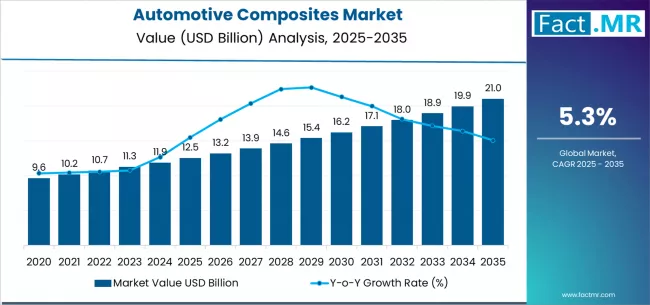
The global automotive composites market represents a critical segment within the advanced automotive materials and vehicle manufacturing industry, driven by the superior weight reduction profile of composite-based products and the diverse functional properties of various automotive composite types. These specialized composite materials are produced through precision manufacturing processes, providing consistent automotive standards and standardized performance characteristics for various vehicle and automotive applications including structural components, body panels, and specialized automotive part manufacturing. The processing mechanism enables controlled weight optimization development, making these products particularly suitable for automotive manufacturers and applications requiring specific strength-to-weight characteristics.
The market encompasses various material types, manufacturing grades, and specialized processing methods tailored for specific automotive requirements. Modern automotive composite production incorporates advanced manufacturing technology, fiber reinforcement optimization, and enhanced processing techniques that can deliver consistent quality across variable composite formulations while maintaining automotive integrity over extended vehicle lifecycles. The integration of quality control systems, automotive compliance protocols, and standardized processing parameters has further enhanced the value proposition of these composite materials among vehicle manufacturers seeking reliable material performance and consistent automotive outcomes.
Market dynamics are significantly influenced by rising fuel efficiency regulations, particularly in developed markets where emission standards and performance-focused consumption patterns drive demand for lightweight composite materials. The automotive sector's increasing emphasis on weight reduction materials, advanced material formulations, and specialized automotive applications has created substantial demand for high-quality automotive composite solutions in vehicle applications, component production, and automotive part manufacturing. The growing trend toward electric vehicles and advanced automotive technologies has amplified the need for versatile composite materials capable of supporting diverse automotive requirements and manufacturing applications.
Consumer purchasing patterns show a marked preference for certified automotive composite varieties that combine advanced processing methods with consistent performance characteristics, multiple application options, and comprehensive automotive profiles for diverse vehicle applications. The market has witnessed significant technological advancement in manufacturing efficiency design, quality control systems, and automotive compliance solutions, making these products more suitable for demanding automotive environments, extended performance requirements, and safety-critical automotive operations.
Between 2025 and 2030, the automotive composites market is projected to expand from USD 12.5 billion to USD 16.2 billion, resulting in a value increase of USD 3.7 billion, which represents 43.5% of the total forecast growth for the decade. This phase of development will be shaped by increasing lightweight material adoption, rising demand for alternative composite solutions, and growing availability of premium automotive composite varieties across automotive and manufacturing channels.
Between 2030 and 2035, the market is forecast to grow from USD 16.2 billion to USD 21.0 billion, adding another USD 4.8 billion, which constitutes 56.5% of the overall ten-year expansion. This period is expected to be characterized by the advancement of specialty automotive composite applications, the development of enhanced composite materials for automotive improvement, and the expansion of certified automotive composite availability across diverse vehicle and manufacturing segments. The growing emphasis on lightweight materials and advanced automotive processing will drive demand for premium automotive composite varieties with enhanced functional properties, improved performance characteristics, and superior automotive profiles in specialized vehicle applications.
Between 2020 and 2024, the automotive composites market experienced steady growth, driven by increasing awareness of lightweight material benefits and growing recognition of automotive composites' effectiveness in vehicle applications following extensive automotive technology campaigns. The market developed as manufacturers recognized the advantages of automotive composites over traditional material alternatives in weight-sensitive applications and began seeking specialized products designed for specific strength and performance requirements. Technological advancement in manufacturing technology and automotive compliance began emphasizing the critical importance of maintaining automotive integrity while enhancing functional performance and improving safety across diverse automotive composite applications.
Automotive Composites Market Key Takeaways
| Metric | Value |
|---|---|
| Estimated Value in (2025E) | USD 12.5 billion |
| Forecast Value in (2035F) | USD 21.0 billion |
| Forecast CAGR (2025 to 2035) | 5.3% |
From 2030 to 2035, the market is forecast to grow from USD 16.2 billion to USD 21.0 billion, adding another USD 4.8 billion, which constitutes 56.5% of the overall ten-year expansion. This period is expected to be characterized by the advancement of specialized processing techniques in composite production systems, the integration of quality enhancement protocols for optimal automotive retention, and the development of customized composite formulations for high-performance vehicle applications. The growing emphasis on material functionality and product reliability will drive demand for premium varieties with enhanced processing capabilities, improved storage stability, and superior automotive performance characteristics.
Between 2020 and 2024, the automotive composites market experienced robust growth, driven by increasing awareness of alternative material benefits and growing recognition of specialized composite systems' effectiveness in supporting diverse automotive operations across vehicle facilities and specialty automotive environments. The market developed as users recognized the potential for automotive composite products to deliver functional advantages while meeting modern requirements for lightweight materials and reliable automotive performance. Technological advancement in processing optimization and quality enhancement began emphasizing the critical importance of maintaining material consistency while extending product durability and improving user satisfaction across diverse automotive composite applications.
Why is the Automotive Composites Market Growing?
Market expansion is being supported by the increasing global emphasis on lightweight automotive materials and the corresponding shift toward alternative composite systems that can provide superior weight reduction characteristics while meeting automotive requirements for advanced material solutions and cost-effective fuel efficiency options. Modern automotive manufacturers are increasingly focused on incorporating composite materials that can enhance vehicle performance while satisfying demands for consistent, precisely controlled weight development and optimized automotive profiles. Automotive composites' proven ability to deliver weight reduction excellence, functional versatility, and diverse application possibilities makes them essential materials for performance-focused automotive professionals and quality-focused vehicle manufacturers.
The growing emphasis on lightweight materials and advanced automotive processing is driving demand for high-performance automotive composite systems that can support distinctive vehicle outcomes and comprehensive performance benefits across body panel applications, chassis production, and specialty automotive manufacturing. Automotive preference for composite solutions that combine functional excellence with advanced processing methods is creating opportunities for innovative implementations in both traditional and emerging vehicle applications. The rising influence of fuel efficiency regulations and alternative automotive approaches is also contributing to increased adoption of automotive composite solutions that can provide authentic functional benefits and reliable weight reduction characteristics.
Segmental Analysis
The market is segmented by material, component, and region. By material, the market is divided into carbon fiber, glass fiber, and hybrid composites. Based on component, the market is categorized into body panels, chassis, and interior applications. Regionally, the market is divided into North America, Europe, and Asia-Pacific.
How are Carbon Fiber Composites Shaping Modern Lightweight Vehicle Design and Performance Strategies?
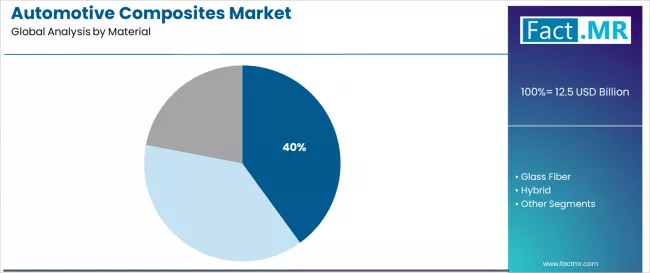
The carbon fiber segment is projected to account for 40.0% of the automotive composites market in 2025, reaffirming its position as the leading material category. Automotive manufacturers and vehicle professionals increasingly utilize carbon fiber composites for their superior strength characteristics, established weight reduction properties, and essential functionality in diverse automotive applications across multiple vehicle sectors. Carbon fiber composite's proven performance characteristics and established cost-effectiveness directly address user requirements for reliable strength control and optimal processing precision in body panel and specialty automotive applications.
This material segment forms the foundation of modern lightweight automotive patterns, as it represents the composite type with the greatest automotive versatility and established compatibility across multiple vehicle systems. Automotive industry investments in alternative material technology and vehicle optimization continue to strengthen adoption among performance-focused manufacturers. With processors prioritizing material reliability and functional consistency, carbon fiber systems align with both performance objectives and automotive requirements, making them the central component of comprehensive vehicle lightweighting strategies.
What makes Body Panels a Dominant Component Category in the Automotive Composites Industry?
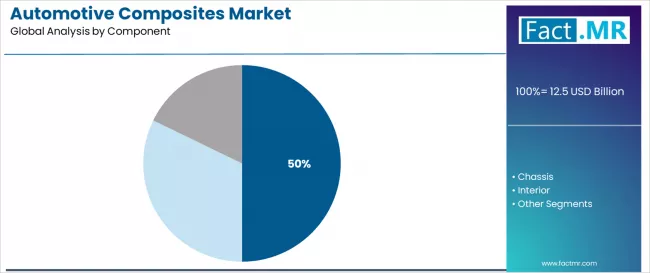
Body panels is projected to represent 50.0% of the automotive composites market in 2025, underscoring its important role as a key application for performance-focused users seeking superior weight reduction and enhanced automotive credentials. Automotive facilities and manufacturing operations prefer body panel applications for their established performance characteristics, proven weight development, and ability to maintain exceptional automotive precision while supporting versatile application coverage during diverse vehicle activities. Positioned as essential applications for quality-focused automotive processors, body panel offerings provide both functional excellence and automotive optimization advantages.
The segment is supported by continuous improvement in automotive technology and the widespread availability of established performance standards that enable quality assurance and premium positioning at the vehicle level. Additionally, automotive facilities are optimizing material selections to support application-specific requirements and comprehensive automotive strategies. As automotive technology continues to advance and facilities seek consistent material performance, body panel applications will continue to drive market growth while supporting operational efficiency and quality optimization strategies.
What are the Drivers, Restraints, and Key Trends of the Automotive Composites Market?
The automotive composites market is advancing rapidly due to increasing lightweight material adoption and growing need for alternative composite solutions that emphasize superior weight reduction performance across automotive segments and specialty vehicle applications.
The market faces challenges, including competition from other alternative material types, price volatility in raw composite materials, and processing complexity considerations affecting production costs. Innovation in manufacturing technology enhancement and specialized composite formulations continues to influence market development and expansion patterns.
Expansion of Lightweight and Performance Applications
The growing adoption of automotive composites with lightweight certification and performance positioning is enabling automotive companies to develop vehicle products that provide distinctive weight reduction benefits while commanding premium pricing and enhanced consumer appeal characteristics.
Lightweight applications provide superior market positioning while allowing more sophisticated product differentiation features across various automotive categories. Automotive companies are increasingly recognizing the market advantages of lightweight composite positioning for comprehensive vehicle outcomes and premium-focused automotive marketing.
Integration of Strength and Durability Enhancement Systems
Modern automotive composite manufacturers are incorporating advanced strength enhancement, durability improvement capabilities, and performance supplementation systems to enhance product functionality, improve automotive effectiveness, and meet consumer demands for enhanced vehicle solutions.
These systems improve product performance while enabling new applications, including specialty automotive programs and specialized vehicle protocols. Advanced performance integration also allows manufacturers to support premium product positioning and automotive assurance beyond traditional composite performance requirements.
How is the Automotive Composites Landscape Evolving Across Key Countries?
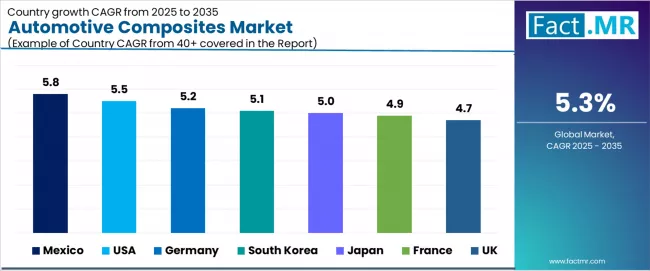
| Country | CAGR (2025-2035) |
|---|---|
| USA | 5.5% |
| UK | 4.7% |
| Germany | 5.2% |
| France | 4.9% |
| Japan | 5.0% |
| South Korea | 5.1% |
| Mexico | 5.8% |
The automotive composites market is experiencing robust growth globally, with USA leading at a 5.5% CAGR through 2035, driven by the expanding automotive manufacturing sector, growing vehicle technology adoption, and increasing adoption of lightweight composite materials. Mexico follows at 5.8%, supported by rising automotive manufacturing capabilities, expanding vehicle industry, and growing acceptance of composite materials.
Germany shows growth at 5.2%, emphasizing established automotive standards and comprehensive lightweight material development. Japan records 5.0%, focusing on automotive industry modernization and vehicle market growth. South Korea demonstrates 5.1% growth, prioritizing advanced automotive technologies and performance-focused vehicle products.
The report covers an in-depth analysis of 40+ countries; seven top-performing countries are highlighted below.
How is the USA leading Global Market Growth through Automotive Expansion?
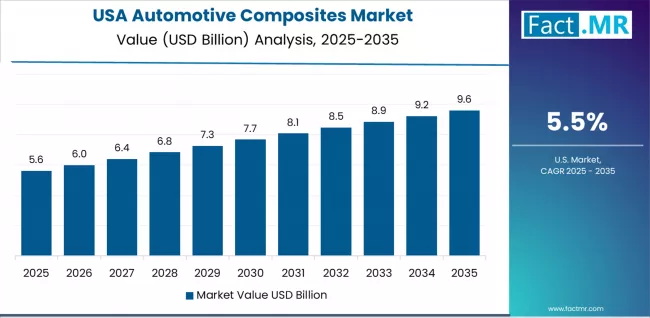
Revenue from automotive composite sales in USA is projected to exhibit exceptional growth with a CAGR of 5.5% through 2035, driven by the country's rapidly expanding automotive manufacturing sector, favorable vehicle policies toward lightweight materials, and initiatives promoting composite development across major automotive regions.
USA's position as a global automotive leader and increasing focus on processed lightweight materials are creating substantial demand for high-quality automotive composites in both domestic and international markets. Major automotive companies and material distributors are establishing comprehensive composite production capabilities to serve growing demand and emerging vehicle opportunities.
- Established automotive culture and expanding vehicle consciousness are driving demand for automotive composites across manufacturing facilities, automotive-oriented companies, and comprehensive material supply systems throughout American automotive markets.
- Strong automotive infrastructure and technology adoption initiatives are supporting the rapid adoption of premium composite varieties among automotive-focused processors seeking to meet evolving performance standards and quality requirements.
Why is Mexico Emerging as a Strong Market with its Manufacturing Focus?
The market for automotive composites in Mexico is expanding at a CAGR of 5.8%, supported by rising domestic automotive consumption, growing processing technology adoption, and expanding material distributor capabilities.
The country's developing automotive infrastructure and increasing investment in processing technologies are driving demand for automotive composites across both traditional and modern automotive applications. International material companies and domestic processors are establishing comprehensive operational networks to address growing market demand for alternative composite products and efficient processing solutions.
- Rising automotive development and expanding processing capabilities are creating opportunities for composite adoption across industrial automotive projects, modern processing developments, and distributor companies throughout major Mexican automotive regions.
- Growing vehicle awareness initiatives and automotive technology advancement are driving the adoption of specialized composite products and services among automotive users seeking to enhance their processing efficiency and meet increasing quality demand.
What enables Germany to Maintain Market Leadership?
Revenue from automotive composite products in Germany is projected to grow at a CAGR of 5.2% through 2035, supported by the country's mature automotive processing standards, established lightweight material regulations, and leadership in specialty composite technology.
Germany's sophisticated automotive standards and strong support for alternative material systems are creating steady demand for both traditional and innovative composite varieties. Leading material manufacturers and specialty distributors are establishing comprehensive operational strategies to serve both domestic markets and growing export opportunities.
- Advanced processing technology capabilities and established automotive-focused markets are driving demand for premium composites across automotive facilities, specialty companies, and comprehensive material companies seeking superior quality profiles and processing innovation.
- Strong quality excellence culture and regulatory leadership are supporting the adoption of innovative composite technology among users prioritizing processing reliability and material precision in automotive applications.
How is the Automotive Composites Ecosystem Shaping Up in Japan?
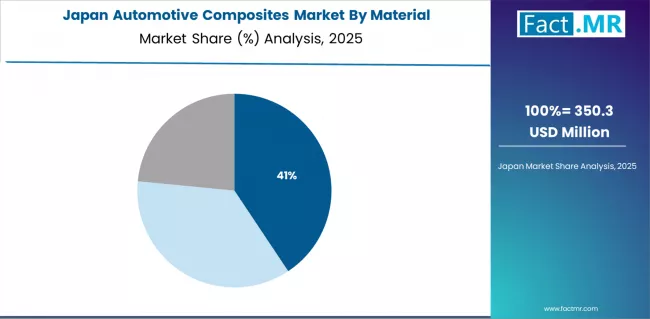
The automotive composites industry in Japan is projected to grow at a CAGR of 5.0% through 2035, driven by the country's emphasis on automotive industry development, material processing growth, and growing distributor capabilities.
Japanese automotive manufacturers and processing facilities consistently seek quality-focused materials that enhance product performance and support processing excellence for both traditional and modern automotive applications. The country's position as an Asian automotive leader continues to drive innovation in specialized composite applications and automotive processing standards.
- Expanding automotive culture and growing vehicle markets are driving demand for industrial composites across processors, material providers, and quality-focused distributors seeking superior processing control and distinctive performance profiles.
- Increasing focus on automotive processing efficiency and vehicle modernization systems is supporting the adoption of specialty composite varieties among users and distributors seeking authentic Japanese processing-focused products in regional markets with established automotive expertise.
What is the Outlook for the Automotive Composites Market in South Korea?
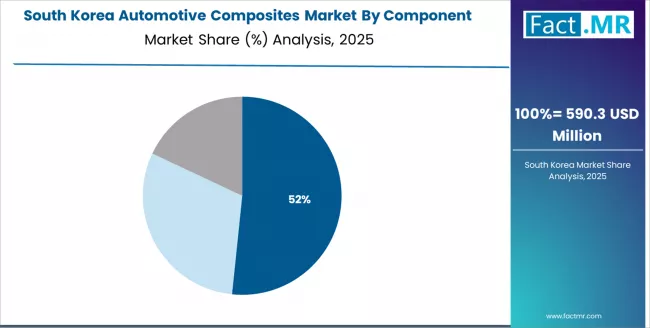
Revenue from automotive composite products in South Korea is projected to grow at a CAGR of 5.1% through 2035, supported by established automotive standards, mature vehicle markets, and emphasis on lightweight alternatives across automotive and industrial sectors.
South Korean manufacturers and specialty processors prioritize quality materials and consistent performance, creating steady demand for premium composite solutions. The country's comprehensive market innovation and established automotive practices support continued development in specialized applications.
- Established automotive markets and mature specialty industry are driving demand for quality composites across operations, facilities, and professional processing companies throughout Korean automotive regions.
- Strong emphasis on quality standards and vehicle awareness is supporting the adoption of premium composite varieties among users seeking proven performance and established automotive credentials in specialty applications.
What Factors are driving France’s Steady Growth with its focus on Automotive Products?
Revenue from automotive composite products in France is projected to grow at a CAGR of 4.9% through 2035, supported by established automotive standards, mature vehicle markets, and emphasis on lightweight alternatives across automotive and manufacturing sectors.
Automotive manufacturers in France and specialty processors prioritize quality materials and consistent performance, creating steady demand for premium composite solutions. The country's comprehensive market maturity and established automotive practices support continued development in specialized applications.
- Established automotive markets and mature specialty industry are driving demand for quality composites across automotive operations, vehicle facilities, and professional processing companies throughout French automotive regions.
- Strong emphasis on quality standards and vehicle awareness is supporting the adoption of premium composite varieties among users seeking proven performance and established automotive credentials in specialty applications.
How is the UK achieving quality-focused growth in the Automotive Composites Industry?
Revenue from automotive composite products in the UK is projected to grow at a CAGR of 4.7% through 2035, supported by the country's emphasis on material quality, automotive excellence, and advanced processing technology integration requiring efficient material solutions.
British automotive facilities and quality-focused operations prioritize technical performance and automotive precision, making specialized composites essential materials for both traditional and modern automotive applications. The country's comprehensive automotive leadership and advancing quality patterns support continued market expansion.
- Advanced automotive technology capabilities and growing technical applications are driving demand for composites across specialty automotive applications, modern formats, and technology-integrated processing programs serving domestic markets with increasing quality requirements.
- Strong focus on automotive precision and material excellence is encouraging users and distributors to adopt composite solutions that support automotive objectives and meet British quality standards for processing applications.
What defines the Market Split of Automotive Composites across European countries?
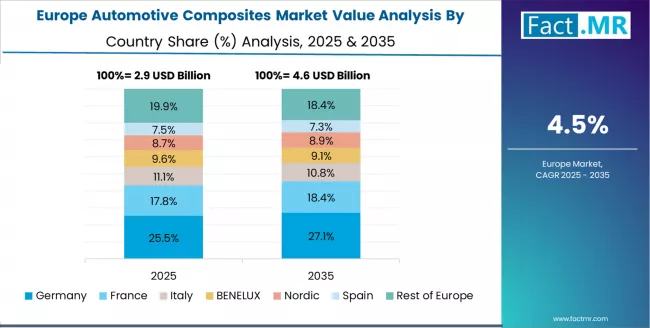
The Europe automotive composites market is projected to grow from USD 3.75 billion in 2025 to USD 6.30 billion by 2035, registering a CAGR of 5.3% over the forecast period. Germany is expected to maintain its leadership position with a 35.0% market share in 2025, declining slightly to 34.5% by 2035, supported by its advanced automotive infrastructure and major vehicle manufacturing hubs including Stuttgart and Munich.
France follows with a 22.0% share in 2025, projected to reach 22.5% by 2035, driven by comprehensive automotive modernization programs and lightweight material initiatives. The UK holds a 20.0% share in 2025, expected to decrease to 19.5% by 2035 due to market maturation.
Italy commands a 15.0% share, while Spain accounts for 8.0% in 2025. The rest of Europe region is anticipated to gain momentum, expanding its collective share from 0.0% to 0.5% by 2035, attributed to increasing composite adoption in Nordic countries and emerging Eastern European markets implementing automotive technology programs.
Competitive Landscape of the Automotive Composites Market
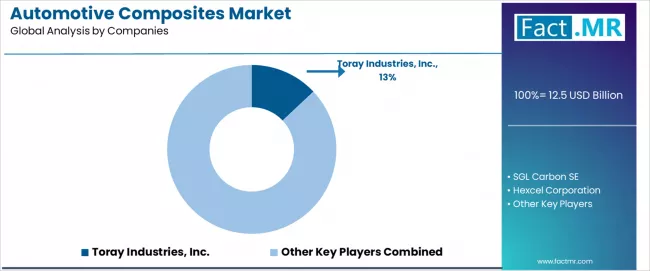
The automotive composites market is characterized by competition among established material manufacturers, specialized composite companies, and integrated automotive processing providers. Companies are investing in advanced manufacturing technologies, specialized processing engineering, product innovation capabilities, and comprehensive distribution networks to deliver consistent, high-quality, and reliable automotive composite products. Innovation in processing efficiency optimization, quality control advancement, and performance-focused product development is central to strengthening market position and customer satisfaction.
Toray Industries Inc. leads the market with 13.0% share with a strong focus on material technology innovation and comprehensive automotive solutions, offering automotive and specialty systems with emphasis on quality excellence and performance heritage. SGL Carbon provides integrated lightweight material solutions with a focus on automotive market applications and functional material networks.
Hexcel delivers comprehensive composite products with a focus on automotive positioning and vehicle quality. Mitsubishi Chemical specializes in composite-based material systems with an emphasis on automotive applications. Gurit focuses on comprehensive composite processing with advanced manufacturing technology and automotive positioning capabilities.
Key Players in the Automotive Composites Market
- Toray Industries, Inc.
- SGL Carbon SE
- Hexcel Corporation
- Mitsubishi Chemical Group Corporation
- Gurit Holding AG
- Teijin Limited
- Owens Corning
- Solvay S.A.
- 3M Company
- BASF SE
- Huntsman Corporation
Scope of the Report
| Items | Values |
|---|---|
| Quantitative Units (2025) | USD 12.5 Billion |
| Material | Carbon Fiber, Glass Fiber, Hybrid |
| Component | Body Panels, Chassis, Interior |
| Regions Covered | North America, Europe, Asia-Pacific |
| Countries Covered | USA, UK, Germany, France, Japan, South Korea, Mexico, and 40+ countries |
| Key Companies Profiled | Toray, SGL Carbon, Hexcel, Mitsubishi Chemical, Gurit, and other leading automotive composite companies |
| Additional Attributes | Dollar sales by material, component, and region; regional demand trends, competitive landscape, technological advancements in composite processing, quality optimization initiatives, performance enhancement programs, and premium product development strategies |
Automotive Composites Market by Segments
-
Material :
- Carbon Fiber
- Glass Fiber
- Hybrid
-
Component :
- Body Panels
- Chassis
- Interior
-
Region :
-
North America
- USA
- Canada
- Mexico
-
Europe
- Germany
- UK
- France
- Italy
- Spain
- Rest of Europe
-
Asia-Pacific
- China
- India
- Japan
- South Korea
- Australia
- Rest of Asia Pacific
-
Table of Content
- Executive Summary
- Global Market Outlook
- Demand to side Trends
- Supply to side Trends
- Technology Roadmap Analysis
- Analysis and Recommendations
- Market Overview
- Market Coverage / Taxonomy
- Market Definition / Scope / Limitations
- Market Background
- Market Dynamics
- Drivers
- Restraints
- Opportunity
- Trends
- Scenario Forecast
- Demand in Optimistic Scenario
- Demand in Likely Scenario
- Demand in Conservative Scenario
- Opportunity Map Analysis
- Product Life Cycle Analysis
- Supply Chain Analysis
- Investment Feasibility Matrix
- Value Chain Analysis
- PESTLE and Porter’s Analysis
- Regulatory Landscape
- Regional Parent Market Outlook
- Production and Consumption Statistics
- Import and Export Statistics
- Market Dynamics
- Global Market Analysis 2020 to 2024 and Forecast, 2025 to 2035
- Historical Market Size Value (USD Million) Analysis, 2020 to 2024
- Current and Future Market Size Value (USD Million) Projections, 2025 to 2035
- Y to o to Y Growth Trend Analysis
- Absolute $ Opportunity Analysis
- Global Market Pricing Analysis 2020 to 2024 and Forecast 2025 to 2035
- Global Market Analysis 2020 to 2024 and Forecast 2025 to 2035, By Material
- Introduction / Key Findings
- Historical Market Size Value (USD Million) Analysis By Material , 2020 to 2024
- Current and Future Market Size Value (USD Million) Analysis and Forecast By Material , 2025 to 2035
- Carbon Fiber
- Glass Fiber
- Hybrid
- Y to o to Y Growth Trend Analysis By Material , 2020 to 2024
- Absolute $ Opportunity Analysis By Material , 2025 to 2035
- Global Market Analysis 2020 to 2024 and Forecast 2025 to 2035, By Component
- Introduction / Key Findings
- Historical Market Size Value (USD Million) Analysis By Component, 2020 to 2024
- Current and Future Market Size Value (USD Million) Analysis and Forecast By Component, 2025 to 2035
- Body Panels
- Chassis
- Interior
- Y to o to Y Growth Trend Analysis By Component, 2020 to 2024
- Absolute $ Opportunity Analysis By Component, 2025 to 2035
- Global Market Analysis 2020 to 2024 and Forecast 2025 to 2035, By Region
- Introduction
- Historical Market Size Value (USD Million) Analysis By Region, 2020 to 2024
- Current Market Size Value (USD Million) Analysis and Forecast By Region, 2025 to 2035
- North America
- Latin America
- Western Europe
- Eastern Europe
- East Asia
- South Asia and Pacific
- Middle East & Africa
- Market Attractiveness Analysis By Region
- North America Market Analysis 2020 to 2024 and Forecast 2025 to 2035, By Country
- Historical Market Size Value (USD Million) Trend Analysis By Market Taxonomy, 2020 to 2024
- Market Size Value (USD Million) Forecast By Market Taxonomy, 2025 to 2035
- By Country
- USA
- Canada
- Mexico
- By Material
- By Component
- By Country
- Market Attractiveness Analysis
- By Country
- By Material
- By Component
- Key Takeaways
- Latin America Market Analysis 2020 to 2024 and Forecast 2025 to 2035, By Country
- Historical Market Size Value (USD Million) Trend Analysis By Market Taxonomy, 2020 to 2024
- Market Size Value (USD Million) Forecast By Market Taxonomy, 2025 to 2035
- By Country
- Brazil
- Chile
- Rest of Latin America
- By Material
- By Component
- By Country
- Market Attractiveness Analysis
- By Country
- By Material
- By Component
- Key Takeaways
- Western Europe Market Analysis 2020 to 2024 and Forecast 2025 to 2035, By Country
- Historical Market Size Value (USD Million) Trend Analysis By Market Taxonomy, 2020 to 2024
- Market Size Value (USD Million) Forecast By Market Taxonomy, 2025 to 2035
- By Country
- Germany
- UK
- Italy
- Spain
- France
- Nordic
- BENELUX
- Rest of Western Europe
- By Material
- By Component
- By Country
- Market Attractiveness Analysis
- By Country
- By Material
- By Component
- Key Takeaways
- Eastern Europe Market Analysis 2020 to 2024 and Forecast 2025 to 2035, By Country
- Historical Market Size Value (USD Million) Trend Analysis By Market Taxonomy, 2020 to 2024
- Market Size Value (USD Million) Forecast By Market Taxonomy, 2025 to 2035
- By Country
- Russia
- Poland
- Hungary
- Balkan & Baltic
- Rest of Eastern Europe
- By Material
- By Component
- By Country
- Market Attractiveness Analysis
- By Country
- By Material
- By Component
- Key Takeaways
- East Asia Market Analysis 2020 to 2024 and Forecast 2025 to 2035, By Country
- Historical Market Size Value (USD Million) Trend Analysis By Market Taxonomy, 2020 to 2024
- Market Size Value (USD Million) Forecast By Market Taxonomy, 2025 to 2035
- By Country
- China
- Japan
- South Korea
- By Material
- By Component
- By Country
- Market Attractiveness Analysis
- By Country
- By Material
- By Component
- Key Takeaways
- South Asia and Pacific Market Analysis 2020 to 2024 and Forecast 2025 to 2035, By Country
- Historical Market Size Value (USD Million) Trend Analysis By Market Taxonomy, 2020 to 2024
- Market Size Value (USD Million) Forecast By Market Taxonomy, 2025 to 2035
- By Country
- India
- ASEAN
- Australia & New Zealand
- Rest of South Asia and Pacific
- By Material
- By Component
- By Country
- Market Attractiveness Analysis
- By Country
- By Material
- By Component
- Key Takeaways
- Middle East & Africa Market Analysis 2020 to 2024 and Forecast 2025 to 2035, By Country
- Historical Market Size Value (USD Million) Trend Analysis By Market Taxonomy, 2020 to 2024
- Market Size Value (USD Million) Forecast By Market Taxonomy, 2025 to 2035
- By Country
- Kingdom of Saudi Arabia
- Other GCC Countries
- Turkiye
- South Africa
- Other African Union
- Rest of Middle East & Africa
- By Material
- By Component
- By Country
- Market Attractiveness Analysis
- By Country
- By Material
- By Component
- Key Takeaways
- Key Countries Market Analysis
- USA
- Pricing Analysis
- Market Share Analysis, 2024
- By Material
- By Component
- Canada
- Pricing Analysis
- Market Share Analysis, 2024
- By Material
- By Component
- Mexico
- Pricing Analysis
- Market Share Analysis, 2024
- By Material
- By Component
- Brazil
- Pricing Analysis
- Market Share Analysis, 2024
- By Material
- By Component
- Chile
- Pricing Analysis
- Market Share Analysis, 2024
- By Material
- By Component
- Germany
- Pricing Analysis
- Market Share Analysis, 2024
- By Material
- By Component
- UK
- Pricing Analysis
- Market Share Analysis, 2024
- By Material
- By Component
- Italy
- Pricing Analysis
- Market Share Analysis, 2024
- By Material
- By Component
- Spain
- Pricing Analysis
- Market Share Analysis, 2024
- By Material
- By Component
- France
- Pricing Analysis
- Market Share Analysis, 2024
- By Material
- By Component
- India
- Pricing Analysis
- Market Share Analysis, 2024
- By Material
- By Component
- ASEAN
- Pricing Analysis
- Market Share Analysis, 2024
- By Material
- By Component
- Australia & New Zealand
- Pricing Analysis
- Market Share Analysis, 2024
- By Material
- By Component
- China
- Pricing Analysis
- Market Share Analysis, 2024
- By Material
- By Component
- Japan
- Pricing Analysis
- Market Share Analysis, 2024
- By Material
- By Component
- South Korea
- Pricing Analysis
- Market Share Analysis, 2024
- By Material
- By Component
- Russia
- Pricing Analysis
- Market Share Analysis, 2024
- By Material
- By Component
- Poland
- Pricing Analysis
- Market Share Analysis, 2024
- By Material
- By Component
- Hungary
- Pricing Analysis
- Market Share Analysis, 2024
- By Material
- By Component
- Kingdom of Saudi Arabia
- Pricing Analysis
- Market Share Analysis, 2024
- By Material
- By Component
- Turkiye
- Pricing Analysis
- Market Share Analysis, 2024
- By Material
- By Component
- South Africa
- Pricing Analysis
- Market Share Analysis, 2024
- By Material
- By Component
- USA
- Market Structure Analysis
- Competition Dashboard
- Competition Benchmarking
- Market Share Analysis of Top Players
- By Regional
- By Material
- By Component
- Competition Analysis
- Competition Deep Dive
- Toray Industries, Inc.
- Overview
- Product Portfolio
- Profitability by Market Segments (Product/Age /Sales Channel/Region)
- Sales Footprint
- Strategy Overview
- Marketing Strategy
- Product Strategy
- Channel Strategy
- SGL Carbon SE
- Hexcel Corporation
- Mitsubishi Chemical Group Corporation
- Gurit Holding AG
- Teijin Limited
- Owens Corning
- Solvay S.A.
- 3M Company
- BASF SE
- Huntsman Corporation
- Toray Industries, Inc.
- Competition Deep Dive
- Assumptions & Acronyms Used
- Research Methodology
List Of Table
- Table 1: Global Market Value (USD Million) Forecast by Region, 2020 to 2035
- Table 2: Global Market Value (USD Million) Forecast by Material , 2020 to 2035
- Table 3: Global Market Value (USD Million) Forecast by Component, 2020 to 2035
- Table 4: North America Market Value (USD Million) Forecast by Country, 2020 to 2035
- Table 5: North America Market Value (USD Million) Forecast by Material , 2020 to 2035
- Table 6: North America Market Value (USD Million) Forecast by Component, 2020 to 2035
- Table 7: Latin America Market Value (USD Million) Forecast by Country, 2020 to 2035
- Table 8: Latin America Market Value (USD Million) Forecast by Material , 2020 to 2035
- Table 9: Latin America Market Value (USD Million) Forecast by Component, 2020 to 2035
- Table 10: Western Europe Market Value (USD Million) Forecast by Country, 2020 to 2035
- Table 11: Western Europe Market Value (USD Million) Forecast by Material , 2020 to 2035
- Table 12: Western Europe Market Value (USD Million) Forecast by Component, 2020 to 2035
- Table 13: Eastern Europe Market Value (USD Million) Forecast by Country, 2020 to 2035
- Table 14: Eastern Europe Market Value (USD Million) Forecast by Material , 2020 to 2035
- Table 15: Eastern Europe Market Value (USD Million) Forecast by Component, 2020 to 2035
- Table 16: East Asia Market Value (USD Million) Forecast by Country, 2020 to 2035
- Table 17: East Asia Market Value (USD Million) Forecast by Material , 2020 to 2035
- Table 18: East Asia Market Value (USD Million) Forecast by Component, 2020 to 2035
- Table 19: South Asia and Pacific Market Value (USD Million) Forecast by Country, 2020 to 2035
- Table 20: South Asia and Pacific Market Value (USD Million) Forecast by Material , 2020 to 2035
- Table 21: South Asia and Pacific Market Value (USD Million) Forecast by Component, 2020 to 2035
- Table 22: Middle East & Africa Market Value (USD Million) Forecast by Country, 2020 to 2035
- Table 23: Middle East & Africa Market Value (USD Million) Forecast by Material , 2020 to 2035
- Table 24: Middle East & Africa Market Value (USD Million) Forecast by Component, 2020 to 2035
List Of Figures
- Figure 1: Global Market Pricing Analysis
- Figure 2: Global Market Value (USD Million) Forecast 2020-2035
- Figure 3: Global Market Value Share and BPS Analysis by Material , 2025 and 2035
- Figure 4: Global Market Y to o to Y Growth Comparison by Material , 2025-2035
- Figure 5: Global Market Attractiveness Analysis by Material
- Figure 6: Global Market Value Share and BPS Analysis by Component, 2025 and 2035
- Figure 7: Global Market Y to o to Y Growth Comparison by Component, 2025-2035
- Figure 8: Global Market Attractiveness Analysis by Component
- Figure 9: Global Market Value (USD Million) Share and BPS Analysis by Region, 2025 and 2035
- Figure 10: Global Market Y to o to Y Growth Comparison by Region, 2025-2035
- Figure 11: Global Market Attractiveness Analysis by Region
- Figure 12: North America Market Incremental Dollar Opportunity, 2025-2035
- Figure 13: Latin America Market Incremental Dollar Opportunity, 2025-2035
- Figure 14: Western Europe Market Incremental Dollar Opportunity, 2025-2035
- Figure 15: Eastern Europe Market Incremental Dollar Opportunity, 2025-2035
- Figure 16: East Asia Market Incremental Dollar Opportunity, 2025-2035
- Figure 17: South Asia and Pacific Market Incremental Dollar Opportunity, 2025-2035
- Figure 18: Middle East & Africa Market Incremental Dollar Opportunity, 2025-2035
- Figure 19: North America Market Value Share and BPS Analysis by Country, 2025 and 2035
- Figure 20: North America Market Value Share and BPS Analysis by Material , 2025 and 2035
- Figure 21: North America Market Y to o to Y Growth Comparison by Material , 2025-2035
- Figure 22: North America Market Attractiveness Analysis by Material
- Figure 23: North America Market Value Share and BPS Analysis by Component, 2025 and 2035
- Figure 24: North America Market Y to o to Y Growth Comparison by Component, 2025-2035
- Figure 25: North America Market Attractiveness Analysis by Component
- Figure 26: Latin America Market Value Share and BPS Analysis by Country, 2025 and 2035
- Figure 27: Latin America Market Value Share and BPS Analysis by Material , 2025 and 2035
- Figure 28: Latin America Market Y to o to Y Growth Comparison by Material , 2025-2035
- Figure 29: Latin America Market Attractiveness Analysis by Material
- Figure 30: Latin America Market Value Share and BPS Analysis by Component, 2025 and 2035
- Figure 31: Latin America Market Y to o to Y Growth Comparison by Component, 2025-2035
- Figure 32: Latin America Market Attractiveness Analysis by Component
- Figure 33: Western Europe Market Value Share and BPS Analysis by Country, 2025 and 2035
- Figure 34: Western Europe Market Value Share and BPS Analysis by Material , 2025 and 2035
- Figure 35: Western Europe Market Y to o to Y Growth Comparison by Material , 2025-2035
- Figure 36: Western Europe Market Attractiveness Analysis by Material
- Figure 37: Western Europe Market Value Share and BPS Analysis by Component, 2025 and 2035
- Figure 38: Western Europe Market Y to o to Y Growth Comparison by Component, 2025-2035
- Figure 39: Western Europe Market Attractiveness Analysis by Component
- Figure 40: Eastern Europe Market Value Share and BPS Analysis by Country, 2025 and 2035
- Figure 41: Eastern Europe Market Value Share and BPS Analysis by Material , 2025 and 2035
- Figure 42: Eastern Europe Market Y to o to Y Growth Comparison by Material , 2025-2035
- Figure 43: Eastern Europe Market Attractiveness Analysis by Material
- Figure 44: Eastern Europe Market Value Share and BPS Analysis by Component, 2025 and 2035
- Figure 45: Eastern Europe Market Y to o to Y Growth Comparison by Component, 2025-2035
- Figure 46: Eastern Europe Market Attractiveness Analysis by Component
- Figure 47: East Asia Market Value Share and BPS Analysis by Country, 2025 and 2035
- Figure 48: East Asia Market Value Share and BPS Analysis by Material , 2025 and 2035
- Figure 49: East Asia Market Y to o to Y Growth Comparison by Material , 2025-2035
- Figure 50: East Asia Market Attractiveness Analysis by Material
- Figure 51: East Asia Market Value Share and BPS Analysis by Component, 2025 and 2035
- Figure 52: East Asia Market Y to o to Y Growth Comparison by Component, 2025-2035
- Figure 53: East Asia Market Attractiveness Analysis by Component
- Figure 54: South Asia and Pacific Market Value Share and BPS Analysis by Country, 2025 and 2035
- Figure 55: South Asia and Pacific Market Value Share and BPS Analysis by Material , 2025 and 2035
- Figure 56: South Asia and Pacific Market Y to o to Y Growth Comparison by Material , 2025-2035
- Figure 57: South Asia and Pacific Market Attractiveness Analysis by Material
- Figure 58: South Asia and Pacific Market Value Share and BPS Analysis by Component, 2025 and 2035
- Figure 59: South Asia and Pacific Market Y to o to Y Growth Comparison by Component, 2025-2035
- Figure 60: South Asia and Pacific Market Attractiveness Analysis by Component
- Figure 61: Middle East & Africa Market Value Share and BPS Analysis by Country, 2025 and 2035
- Figure 62: Middle East & Africa Market Value Share and BPS Analysis by Material , 2025 and 2035
- Figure 63: Middle East & Africa Market Y to o to Y Growth Comparison by Material , 2025-2035
- Figure 64: Middle East & Africa Market Attractiveness Analysis by Material
- Figure 65: Middle East & Africa Market Value Share and BPS Analysis by Component, 2025 and 2035
- Figure 66: Middle East & Africa Market Y to o to Y Growth Comparison by Component, 2025-2035
- Figure 67: Middle East & Africa Market Attractiveness Analysis by Component
- Figure 68: Global Market - Tier Structure Analysis
- Figure 69: Global Market - Company Share Analysis
- FAQs -
How big is the automotive composites market in 2025?
The global automotive composites market is estimated to be valued at USD 12.5 billion in 2025.
What will be the size of automotive composites market in 2035?
The market size for the automotive composites market is projected to reach USD 21.0 billion by 2035.
How much will be the automotive composites market growth between 2025 and 2035?
The automotive composites market is expected to grow at a 5.3% CAGR between 2025 and 2035.
What are the key product types in the automotive composites market?
The key product types in automotive composites market are carbon fiber, glass fiber and hybrid.
Which component segment to contribute significant share in the automotive composites market in 2025?
In terms of component, body panels segment to command 50.0% share in the automotive composites market in 2025.